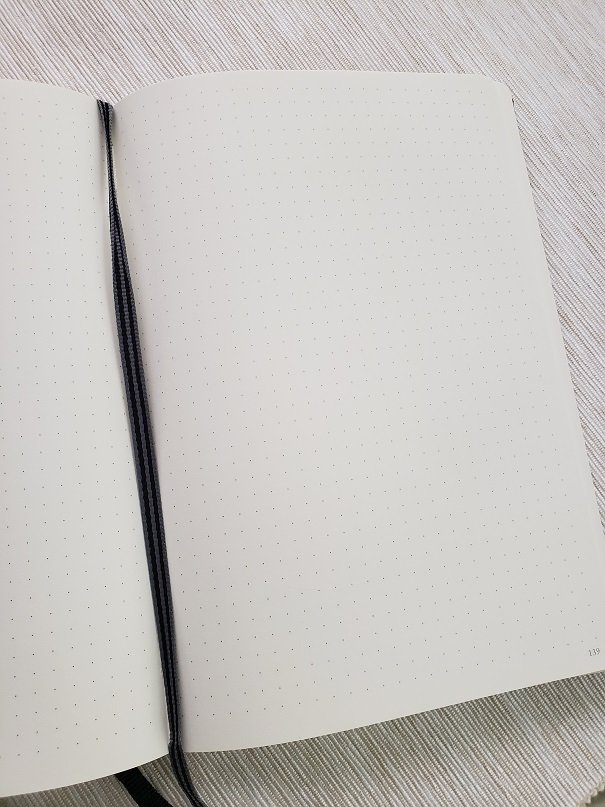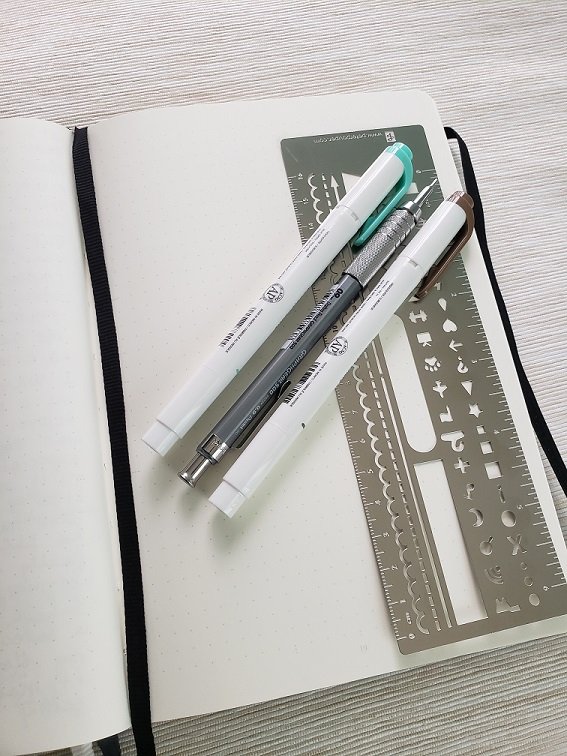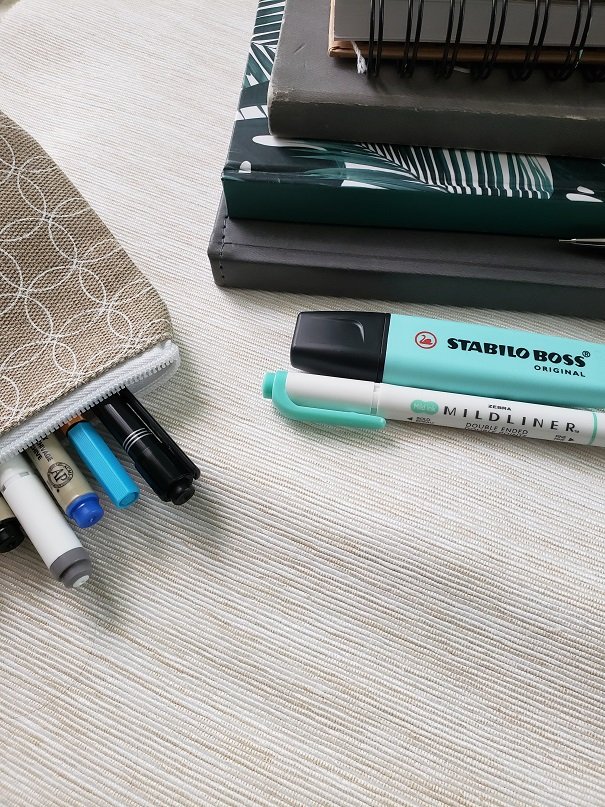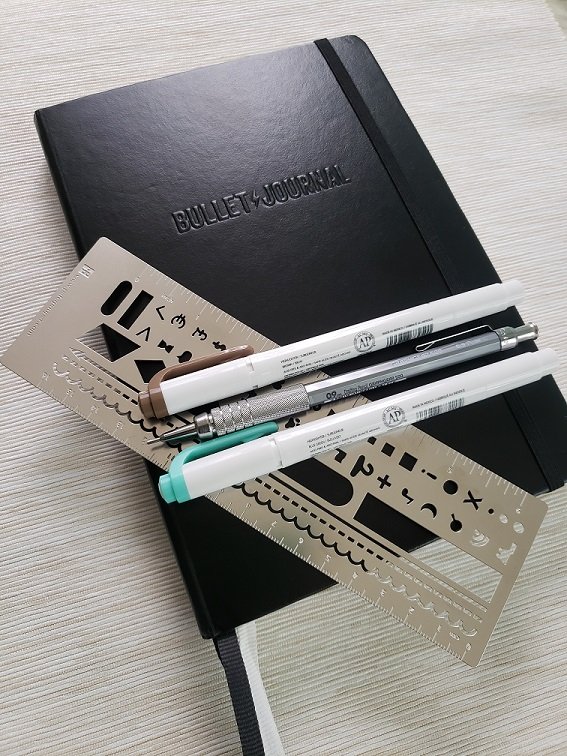Bullet Journal been gaining popularity in the recent year and for a good reason. It’s flexible, customizable and it grows with you. So, if you wanted to give it a try, what do you need for Bullet Journal?
What materials are needed for Bullet Journal? All you need for a Bullet Journal is a notebook and a writing instrument. Traditional Bullet Journal is a dot grid notebook and the suggested writing instrument is a pen.
Of course, as simple as these materials sound, there are many options for both notebooks and the writing instruments you use in the Bullet Journal. Let’s take a look at some of them.
Bullet Journal Notebooks
Bullet Journal is name so because it’s based on bulleted lists as a way to organize your life and be productive.
The original Bullet Journal was designed in a dot grid notebook. Because of that, traditionally the Bullet Journal notebook is thought of as having to be a dot grid notebook, but it’s not entirely true.
The Bullet Journal is intended to be designed in a way that works for you, you can choose any notebook that does the job. Here are some notebooks you can consider for your Bullet Journal setup.
Dot Grid Notebooks
A dot grid notebook is a notebook that has plain paper that is covered, at even distances, vertically and horizontally, with dots. Depending on the notebook maker, the dots can be from very light, serving as a guide, to very dark, creating a solid structure for your notes.

Some dot grid notebooks have page numbers in the lower corners, some don’t. Some dot grid notebooks are even designed with the Bullet Journal system in mind and will have pre-printed pages like Key, Index and Future Log.
The original Bullet Journal was created using Leuchtturm1917 dotted notebook and this brand been associated with this system ever since. Until today, all the branded Bullet Journals are made using Leuchtturm1917 dotted notebook.
Just recently, a new of the Bullet Journal Edition 2 came out featuring thicker, bleed-proof paper, line guides, stickers and Getting Started guide.
The first run is offered in classic Black color in addition to Blush (powder rose) color. Every year a different color will be offered so that you can track the years by the color-coded spines of your Bullet Journals.
Of course, Leuchtturm1917 is not the only dotted notebook on the market.
There are comparable, slightly better-priced offered on the market from the smaller brands like BooQool and PAPERAGE, as well as similarly-priced dotted notebooks from well-known brands like Moleskine and Wordsworth & Black.
Each notebook offers different shade of paper color as well as different thickness and quality of paper.
Squared/Graph Notebooks
Next closest to dot grid in my mind is a graph/squared notebook.
It features graph paper on the pages, the kind you might have used in your math or engineering class. I personally love graph notebooks as they bring order to information and a peace to my mind.

With dot grid notebooks, the dots sometimes are so faint that I can barely see them and, as a result, the writing slants and comes out uneven. But hey, that’s my personal opinion.
The advantage of using the graph/squared notebook for Bullet Journal is that a lot of the layouts (spreads) in the Bullet Journal feature various sized boxes and lines drawn by hand. The graph paper offers a perfect guide for the lines of the various spreads, be they hand-drawn or drawn using a ruler.
Graph paper creates a perfect structure for your page layouts, as well an excellent format for the bulleted lists, notes, calendars, trackers and so on.
The graph/squared notebooks available from the many of the same manufacturers as the dotted notebooks.
Both Leuchtturm1917 and Moleskin make squared notebooks, as well as Scribbles That Matter, RETTACY, Northbooks and even Amazon itself with it’s Amazon Basics.
Lined Notebooks
It’s not secret that not everyone like the grids and squares. As much as I love them, to others they might feel too structured, too restrictive. I know of many creative souls that love their lined notebook since the were kids and till the end of time.
There is no reason not to have a Bullet Journal only cause you like to use the lined paper. The BuJo system can be implemented in a lined notebook as well.
Since Bullet Journal is built around spreads that feature boxes and divided pages, these can be easily drawn up in a line notebook using a good ruler. Just count out how many inches/cm the page is long and how many wide, do the basic division for how many columns and rows you are trying to fit and draw up the lines. Voila!

Moreover, the daily Bullet Journal spreads are all about bullet points, you don’t need to draw anything for those.
Just write a dot in the beginning of the line (for the task) and write out what that task should be. Write a dash in the beginning of the line (for the note) and write out your note. Done! See, totally doable.
The great thing about lined notebooks is that they are available from all kinds of manufacturers and in all kinds of the stores. Even the tried and true Composition Notebook can be used for a Bullet Journal!
Plain Notebooks
And, for the total rebels and artsy creative types, a plain notebook is the perfect answer for the Bullet Journal.
Plain notebooks can be used for Bullet Journals that border on the art journals, combining planning, to-do lists with doodles, stickers and art.
In a plain notebook, you can use stamps or stickers to create the calendars and other grids for the Bullet Journal part and watercolors, markers and pastels for the art journal part – the world is your oyster!
Just like the lined notebooks, plain notebooks are available from a variety of retailers, in different shades of cream and white and with different thicknesses of paper (even sketch or watercolor quality).
Writing Instruments for Bullet Journaling
Since the Bullet Journal is, well, a journal, you need a writing instrument to write in it.
The creator of the Bullet Journal, Ryder Carroll, recommends using a pen to write in the journal. He himself, at least in his videos, uses black ink pen so the writing is really clear and it stands out on the page.
However, just like with the notebook, you can choose whatever writing instrument works for you.
Bullet Journaling with Pencils
I’m a perfectionist, there I said it. As such, writing with a pen intimidates me. Especially in a brand new notebook. The perfection of the clean page freaks me out and, at times, prevents me from journaling. To go around this issue, I often journal in pencil.
Pencils are trusty old friends that come in different harnesses of the lead, sizes and even shapes. Pencils come in the classic wood and more modern mechanical form.

Depending on how hard (or soft) is the graphite in the pencil’s lead, the pencil can be scratchy and down-right cringy or soft and gliding on the page.
I’m from the camp that can’t stand the sound of the pencil on the page (I was raised on calligraphy and fountain pens) and for years I kept away from the pencils. The white-out was my friend for those time when I messed up.
But then I discovered a professional grade graphing pencil that came with a 0.9mm led. The led was wide and made out of soft type of graphite and it was like writing with a pen (but erasable!).
I’ve been journaling in pencil ever since.
If you want to see all the pros and cons of journaling with a pencil, check out a blog post here.
Pens for Journaling

Pens are the ying and yang of journaling. You can’t imagine a journal or a diary without a trusty pen. And they come in such an amazing variety of inks, viscosities, thicknesses and colors!
Ball-point pens
Good old classic, ball-point pens been around forever. Love them or hate them, we have used them in school, at home and at work. They went from black, blue and red, crappy ink and hard to roll balls, to all colors of rainbow, amazing smoothness and super-fine, fine and other sizes.
I still love me a good ball-point pen. One of my fave is Pentel WOW!
Ink and ink-gel pens
As good as ball-point pens were, the paste they are loaded with is quite temperamental.
It can get thick and cruddy and refuse to come out or drag on a page like a torture. It can get too runny when it’s hot or get cold and not come out at all. So? Ink and ink-gel pens to the rescue!
The ink in them is thinner and the ball is smaller, so the ink comes out more freely and the pen glides smoother, ah, the joy. The writing with ink pens comes out darker and stands out more.
The downside of these pens is that the ink takes a bit longer to dry, smudges and can bleed to the other side of the page. It can also leak in your pocket if you are not careful!
Fountain Pens (refillable and cartridge ones)
All hail fountain pens… Aaaahhh, do you hear the angels sing?
Ok, maybe not angels, but the fountain pens are such gorgeous prime example of a writing tool, they are the epitome of all the writing instruments. They have been around for centuries – in form of feathers, then metal-nib plumes, then pens with refillable barrels, then pens with replaceable ink cartridges.
Fountain pens can be intimidating – there is that refilling dilemma and possible ink mess. The nib of a fountain pen is very particular and needs to be held in a specific way to be able to write with it and get the smoothest glide. And of course, the writing needs to be blotted to avoid smearing and ghosting.
But with all the perceived difficulties of the fountain pen come all the rewards.
Fountain pens make excellent tools for learning calligraphy, for developing an even, beautiful, skilled handwriting. Fountain pens make your pages that much more attractive. And most importantly – because writing with a fountain pen is slow, it makes your journaling deliberate and mindful, something that Bullet Journal method celebrates.
Fine-tip Markers
If none of the writing tools above are you thing, if you want the thickness and inkiness of the fountain pen, but no leaks, inks and mess, fine-tip markers can be the answer.
Many makers like Stabilo, iBayam, Staedtler, Micron, Faber Castell, to name a few, make a fine assortment of colors and thicknesses, making these markers excellent not only for writing but also decorating your Bullet Journal.
The fine-tip markers are usually really smooth, give an even ink-flow and most of them don’t bleed through the paper (especially extra fine ones like .003mm).
Other journaling tools
The journal and a pen are the most basics of a Bullet Journal.

To make the most of your journaling experience, you can also get a variety of rulers and stencil, stamps (clear and rubber ones), stickers, washi tapes but also water colors, markers and color pencils.
You can use photos, vintage paper, even lace or dried leaves and flowers to make the journal your own.
Bullet Journal doesn’t require a lot to start, just a notebook and a pen. It can be as simple or elaborate as you want. You can use a variety of notebooks and pens, as well as tools and embellishments to make it do all the things you need it to do.




